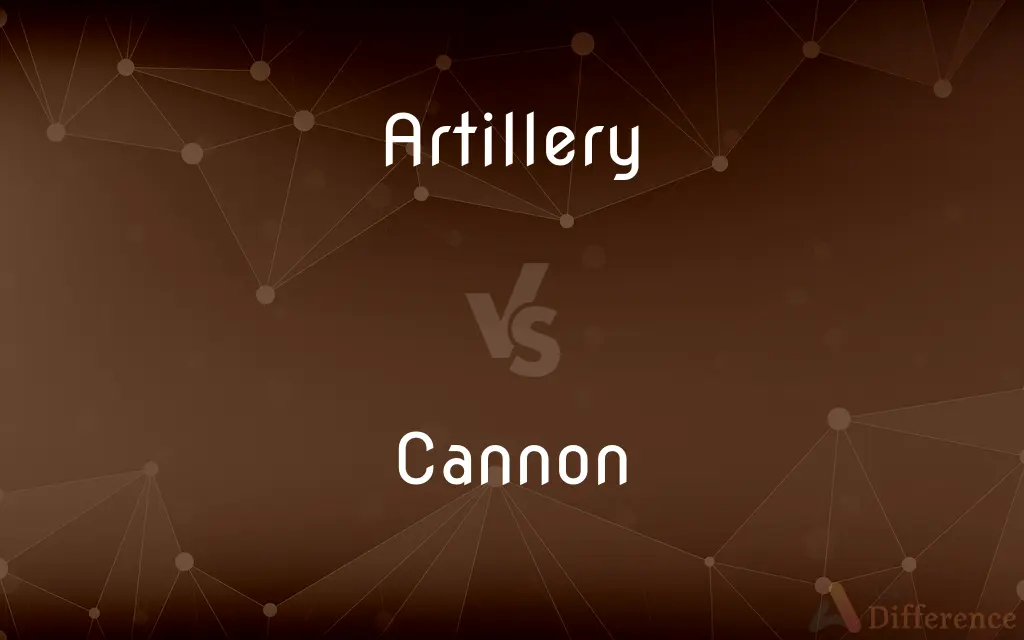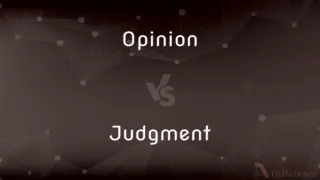Artillery vs. Cannon — What's the Difference?
By Tayyaba Rehman & Urooj Arif — Updated on March 29, 2024
Artillery is a broad category of heavy military weapons designed for long-range firing, while a cannon is a specific type of artillery known for its long barrel and projectile firing capability.

Difference Between Artillery and Cannon
Table of Contents
ADVERTISEMENT
Key Differences
Artillery encompasses a range of heavy military weapons systems designed for land-based warfare, focusing on long-range targets. These systems include howitzers, mortars, cannons, and rocket launchers, each serving specific roles from direct fire support to siege warfare. Whereas, a cannon is a specific type of artillery that operates by launching projectiles using explosive propellant, historically significant for its use in both land and naval battles. It has a long barrel for shooting projectiles towards enemy targets, emphasizing direct fire with a flat trajectory.
While artillery as a whole has evolved to include advanced technology such as guided missiles and rocket-propelled grenades, cannons have largely retained their traditional design, with modern advancements enhancing their firing range, accuracy, and lethality. On the other hand, cannons, especially in their modern incarnations, are often integrated into larger weapon systems, including tanks and warships, illustrating the convergence of historical weaponry with contemporary military technology.
Artillery units in the military are trained to operate a wide array of weapons systems, requiring knowledge of ballistic trajectories, target acquisition, and coordination with other forces. Conversely, cannon operation, while also demanding proficiency in these areas, historically involved more specialized crews due to the mechanical and physical challenges of loading and firing large projectiles.
The deployment of artillery in a battlefield scenario encompasses strategic positioning to maximize the range and effectiveness of the weapons, often behind the front lines to support infantry and tank movements. In contrast, cannons, due to their versatility and mobility, can be found both in fixed positions for defensive purposes and mounted on mobile platforms for offensive operations.
Artillery, given its diverse forms, plays a crucial role in shaping modern warfare tactics, offering both precision strikes and area saturation capabilities. Cannons, while part of this broader category, are often celebrated for their historical significance and continued use in specific scenarios, such as ceremonial salutes and as part of armored vehicle armaments.
ADVERTISEMENT
Comparison Chart
Definition
Broad category of heavy military weapons for long-range firing.
Specific type of artillery with a long barrel for launching projectiles.
Types
Includes cannons, howitzers, mortars, rocket launchers.
One of the primary forms of artillery.
Usage
Varied, including direct fire, siege warfare, and support.
Traditionally used for direct fire with a flat trajectory.
Technology
Ranges from conventional cannons to guided missiles.
Historically significant, with modern versions being more advanced.
Operation
Requires knowledge of ballistics, targeting, and coordination.
Specialized crews for loading and firing, with emphasis on accuracy and power.
Compare with Definitions
Artillery
Includes howitzers, mortars, cannons, and rocket launchers.
The military’s artillery arsenal was a mix of mortars and rocket launchers.
Cannon
A type of artillery with a long barrel for firing projectiles.
The old fortress was armed with cannons from the 18th century.
Artillery
Heavy military weapons designed for long-range bombardment.
The artillery unit was called in to provide support for the infantry.
Cannon
Known for its long barrel and use of explosive propellant to launch projectiles.
The cannon’s design has evolved, but its basic operation remains the same.
Artillery
Has seen significant advancements, from gunpowder to guided munitions.
Modern artillery systems now include precision-guided munitions for increased accuracy.
Cannon
Still used in certain military and ceremonial contexts.
Cannons are fired during military parades as a salute to dignitaries.
Artillery
Requires coordinated teams with specialized training.
The artillery crew trained extensively to master the new howitzer system.
Cannon
Can be mounted on various platforms for different tactical uses.
The mobile cannon was deployed to support the infantry’s advance.
Artillery
Employed for its long-range capabilities in both offensive and defensive roles.
Artillery was positioned on the hill to cover the advancing troops.
Cannon
Played a crucial role in both land and naval warfare.
Cannons were decisive in the naval battles of the Napoleonic Wars.
Artillery
Artillery is a class of heavy military ranged weapons built to launch munitions far beyond the range and power of infantry firearms. Early artillery development focused on the ability to breach defensive walls and fortifications during sieges, and led to heavy, fairly immobile siege engines.
Cannon
A cannon is a large-caliber gun classified as a type of artillery, and usually launches a projectile using explosive chemical propellant. Gunpowder ("black powder") was the primary propellant before the invention of smokeless powder during the late 19th century.
Artillery
Large-caliber weapons, such as cannon, howitzers, and missile launchers, that are operated by crews.
Cannon
A large, heavy piece of artillery, typically mounted on wheels, formerly used in warfare
They would cross at the Town ford, under cover of the defending cannon
Artillery
The branch of an army that specializes in the use of such weapons.
Cannon
A stroke in which the cue ball strikes two balls successively.
Artillery
The science of the use of guns; gunnery.
Cannon
A heavy cylinder or hollow drum that is able to rotate independently on a shaft.
Artillery
Weapons, such as catapults, arbalests, and other early devices, used for discharging missiles.
Cannon
Collide with something forcefully or at an angle
His shot cannoned off the crossbar
The couple behind almost cannoned into us
Artillery
Large projectile weapons, in modern usage usually large guns, but also rocket artillery.
Cannon
Make a cannon shot.
Artillery
An army unit that uses such weapons, or a military formation using projectile weapons, such as archers.
Cannon
A weapon, typically mounted, that fires heavy projectiles from a cylindrical barrel. Cannons include guns, howitzers, and mortars.
Artillery
Gunnery.
Cannon
The loop at the top of a bell by which it is hung.
Artillery
Weapons.
Cannon
A round bit for a horse.
Artillery
Munitions of war; implements for warfare, as slings, bows, and arrows.
And Jonathan gave his artillery unto his lad.
Cannon
(Zoology) The section of the lower leg in some hoofed mammals between the hock or knee and the fetlock, containing the cannon bone.
Artillery
Cannon; great guns; ordnance, including guns, mortars, howitzers, etc., with their equipment of carriages, balls, bombs, and shot of all kinds.
Cannon
Chiefly British A carom made in billiards.
Artillery
The men and officers of that branch of the army to which the care and management of artillery are confided.
Cannon
To bombard with cannon.
Artillery
The science of artillery or gunnery.
Cannon
Chiefly British To cause to carom in billiards.
Artillery
Large but transportable armament
Cannon
To fire cannon.
Artillery
An army unit that uses big guns
Cannon
Chiefly British To make a carom in billiards.
Artillery
A means of persuading or arguing;
He used all his conversational weapons
Cannon
A complete assembly, consisting of an artillery tube and a breech mechanism, firing mechanism or base cap, which is a component of a gun, howitzer or mortar. It may include muzzle appendages.
Cannon
Any similar device for shooting material out of a tube.
Water cannon
Glitter cannon
Cannon
An autocannon.
Cannon
A bone of a horse's leg, between the fetlock joint and the knee or hock.
Cannon
A cannon bit.
Cannon
(historical) A large muzzle-loading artillery piece.
Cannon
A carom.
In English billiards, a cannon is when one's cue ball strikes the other player's cue ball and the red ball on the same shot; and it is worth two points.
Cannon
The arm of a player who can throw well.
He's got a cannon out in right.
Cannon
(engineering) A hollow cylindrical piece carried by a revolving shaft, on which it may, however, revolve independently.
Cannon
(historical) A cylindrical item of plate armor protecting the arm, particularly one of a pair of such cylinders worn with a couter, the upper cannon protecting the upper arm and the lower cannon protecting the forearm.
Cannon
Alternative form of canon
Cannon
(Chinese chess) A piece which moves horizontally and vertically like a rook but captures another piece by jumping over a different piece in the line of attack.
Cannon
A pickpocket.
Cannon
To bombard with cannons.
Cannon
To play the carom billiard shot; to strike two balls with the cue ball.
The white cannoned off the red onto the pink.
Cannon
To fire something, especially spherical, rapidly.
Cannon
To collide or strike violently, especially so as to glance off or rebound.
Cannon
(fandom slang) canon
Cannon
A great gun; a piece of ordnance or artillery; a firearm for discharging heavy shot with great force.
Cannon
A hollow cylindrical piece carried by a revolving shaft, on which it may, however, revolve independently.
Cannon
A kind of type. See Canon.
Cannon
See Carom.
Cannon
To discharge cannon.
Cannon
To collide or strike violently, esp. so as to glance off or rebound; to strike and rebound.
He heard the right-hand goal post crack as a pony cannoned into it - crack, splinter, and fall like a mast.
Cannon
A large artillery gun that is usually on wheels
Cannon
Heavy gun fired from a tank
Cannon
(Middle Ages) a cylindrical piece of armor plate to protect the arm
Cannon
Heavy automatic gun fired from an airplane
Cannon
Lower part of the leg extending from the hock to the fetlock in hoofed mammals
Cannon
A shot in billiards in which the cue ball contacts one object ball and then the other
Cannon
Make a cannon
Cannon
Fire a cannon
Common Curiosities
What advancements have been made in artillery technology?
Advancements include precision-guided munitions, increased range and accuracy, and automated firing systems, significantly enhancing their strategic value.
Are cannons used in naval warfare today?
Modern naval warfare relies more on missiles and torpedoes, but cannons are still used for specific tasks like shore bombardment and close defense.
Can cannons be considered outdated?
While traditional cannon designs have historical significance, modern cannons are technologically advanced and remain integral to certain military operations.
How does the range of artillery compare to other weapons?
Artillery can engage targets at much longer ranges than small arms or grenades, making it essential for hitting strategic enemy positions from a distance.
What distinguishes artillery from a cannon?
Artillery is a broad category that includes various types of heavy, long-range weapons, while a cannon is a specific type of artillery known for its long barrel and projectile firing capability.
Why is precision important in artillery?
Precision reduces collateral damage and ensures that firepower is effectively concentrated on the intended targets, maximizing military effectiveness and minimizing unintended consequences.
Can civilians own historical cannons?
Laws vary by country, but in some places, civilians can own decommissioned or replica cannons, often subject to specific regulations.
How do artillery units support infantry?
Artillery units provide long-range firepower to suppress or destroy enemy positions, supporting infantry movements and enhancing battlefield effectiveness.
What role do cannons play in modern armies?
In modern armies, cannons are part of armored vehicles and tanks, providing direct fire support against enemy positions and vehicles.
How is artillery coordinated in a battle?
Artillery coordination involves careful planning with intelligence and reconnaissance inputs, ensuring strikes are accurate and effective without endangering friendly forces.
Share Your Discovery

Previous Comparison
Parasite vs. Fetus
Next Comparison
Cloudberry vs. SalmonberryAuthor Spotlight
Written by
Tayyaba RehmanTayyaba Rehman is a distinguished writer, currently serving as a primary contributor to askdifference.com. As a researcher in semantics and etymology, Tayyaba's passion for the complexity of languages and their distinctions has found a perfect home on the platform. Tayyaba delves into the intricacies of language, distinguishing between commonly confused words and phrases, thereby providing clarity for readers worldwide.
Co-written by
Urooj ArifUrooj is a skilled content writer at Ask Difference, known for her exceptional ability to simplify complex topics into engaging and informative content. With a passion for research and a flair for clear, concise writing, she consistently delivers articles that resonate with our diverse audience.
















































